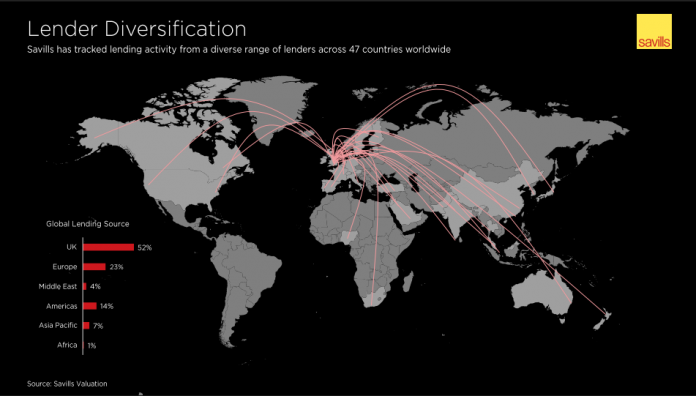The lending market remains very active with lenders from 47 countries actively seeking to deploy debt capital into UK property, the largest number in terms of geographical diversity on record, Savills revealed at its Financing Property presentation in Birmingham today, Wednesday 4th June 2025.
The variety of lender activity in the UK property market suggests investor requirements across broad debt requirements and risk appetite can be fulfilled.
According to the Savills survey*, while respondents were more likely to lend and invest in the living sectors, residential development and prime logistics, the offices, retail and secondary logistics sectors all reported an improvement in lending sentiment compared to last year.
Craig Timney, head of UK valuation operations, says: “The lending market remains highly diverse with lenders from 47 countries worldwide looking to deploy debt capital against UK property – this is the most geographically spread we have seen. Many lenders seem reassured by the fact that the UK is further along in its repricing cycle compared to Europe. Some prime sectors are even experiencing a rise in values. However, pricing uncertainty persists in certain areas, which may be dampening transaction volumes. This, in turn, is causing frustration among lenders due to the limited lending opportunities for new acquisitions.”
According to Bayes just over £36bn of loans were deployed in the UK in 2024, which was up on 2023 levels. Only 31% of that amount related to new acquisitions, which highlights the volume of refinancing activity that is ongoing.
Additionally, the use of Back Leverage (debt funds borrowing money from third party lenders) is becoming a notable feature coming through in lending activity.
David Farrow, head of valuation, Birmingham, adds: “Most lending activity has naturally centred around refinancing, a fair volume of which is from incumbent lenders seeking to amend and extend existing loan agreements whilst working collaboratively with their borrowers. However, some borrowers may face difficulties bridging funding gaps when existing loans mature given the higher funding costs relative to those agreed under the original loan term.
“With instances of over 30 lenders often vying for the same deal, this intense competition is putting downward pressure on both margins and, in some cases, loan-to-value ratios which can lead to favourable outcomes for borrowers. However, for those lenders who miss out, it raises the question of whether we’ll start to see lenders move up the risk curve in pursuit of future opportunities.”
Addressing the commercial property market, Clare Bailey, director in the commercial research team at Savills, notes that while UK commercial investment activity in Q1 2025 was subdued it wasn’t the only country to experience a slowdown with most other major European countries also reporting Q1 investment activity below the five year average. Additionally, global M&A activity reached its lowest point on record in April, suggesting investor capital is not being re-deployed in other areas.
She comments: “The occupational story in Birmingham and the UK as a whole remains solid and rental growth continues, driven by the lack of development. As the noise around tariffs diminishes we should see a boost in investment volumes supported by the resilient occupational story, more debt availability, higher LTVs and some distress. Additionally, the returns could prove too attractive to ignore for some investors with UK Retail and UK Industrial sitting in the top quartile compared to other asset classes, returning over 10% in the year to the end of Q1 2025.”
From a residential perspective, Savills highlights that there have been significant challenges in the short term driven by the stamp duty changes which encouraged transactional activity ahead of the deadline in April 2025. This could translate to lower activity over the coming months. However, development activity is picking up driven by planning reforms which delivers more certainty, especially for smaller developers.
According to the Savills European Investor Survey, PBSA and multifamily living continue to be the most in demand sectors for investment.
Lucian Cook, head of residential research, says: “We are seeing improving affordability in the UK housing market which should help drive activity and pricing, despite economic uncertainty. However, there are still pockets of the market facing weakness amid continued mismatch in pricing expectations and policy changes which has impacted prime markets, particularly in central London.”
* Savills survey of Financing Property 2025 guests




















